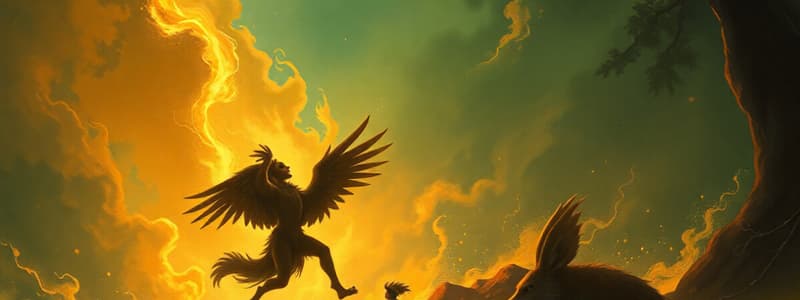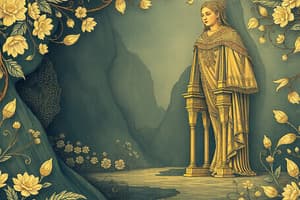Podcast
Questions and Answers
What is the primary purpose of myths in Philippine pre-colonial literature?
What is the primary purpose of myths in Philippine pre-colonial literature?
- To record historical events
- To explain natural phenomena (correct)
- To entertain audiences
- To teach moral lessons
Ribung Linti is known as the deity responsible for ushering in the dry season.
Ribung Linti is known as the deity responsible for ushering in the dry season.
False (B)
What are folk songs an expression of?
What are folk songs an expression of?
The experiences of our ancestors in life.
The story of a hero with extraordinary powers, who went to war at the age of nine months, is called _____.
The story of a hero with extraordinary powers, who went to war at the age of nine months, is called _____.
Match the following literary forms with their descriptions:
Match the following literary forms with their descriptions:
Which of the following is NOT considered a type of traditional narrative in Philippine pre-colonial literature?
Which of the following is NOT considered a type of traditional narrative in Philippine pre-colonial literature?
Doctrina Cristiana was the first book published in the Philippines.
Doctrina Cristiana was the first book published in the Philippines.
What does a proverb express?
What does a proverb express?
The traditional narrative used for witchcraft and enchantments is known as a _____.
The traditional narrative used for witchcraft and enchantments is known as a _____.
Which hero in Philippine literature is born in a unique manner, falling from his mother's hair?
Which hero in Philippine literature is born in a unique manner, falling from his mother's hair?
Who is known as the founder of Diariong Tagalog?
Who is known as the founder of Diariong Tagalog?
Emilio Jacinto is known as the Father of Katipunan.
Emilio Jacinto is known as the Father of Katipunan.
What is a couplet?
What is a couplet?
What is the primary content focus of the Spanish Period literature?
What is the primary content focus of the Spanish Period literature?
The poem form of Japanese literature made up of 17 syllables is called a ___.
The poem form of Japanese literature made up of 17 syllables is called a ___.
A tercet is a triplet in which each line ends with a different rhyme.
A tercet is a triplet in which each line ends with a different rhyme.
Match the following authors with their respective contributions:
Match the following authors with their respective contributions:
What type of imagery pertains to odors and scents?
What type of imagery pertains to odors and scents?
Which of the following best describes the focus of the 'Rebirth of Freedom' themes?
Which of the following best describes the focus of the 'Rebirth of Freedom' themes?
A quatrain is a stanza of ______ lines.
A quatrain is a stanza of ______ lines.
Leonora Florentino is recognized as the Mother of Philippine Women’s Literature.
Leonora Florentino is recognized as the Mother of Philippine Women’s Literature.
Match the imagery type with its corresponding sense:
Match the imagery type with its corresponding sense:
What does the term 'rhyme scheme' refer to?
What does the term 'rhyme scheme' refer to?
What is the notable work of Pedro Bukaneg?
What is the notable work of Pedro Bukaneg?
Francisco Balagtas is known as the Father of ___ and author of Florante at Laura.
Francisco Balagtas is known as the Father of ___ and author of Florante at Laura.
The speaker in a poem is always the same as the poet.
The speaker in a poem is always the same as the poet.
What is the arrangement of words and lines in poetry called?
What is the arrangement of words and lines in poetry called?
Which of the following works is NOT written by Jose Rizal?
Which of the following works is NOT written by Jose Rizal?
______ imagery involves the sense of touch and physical textures.
______ imagery involves the sense of touch and physical textures.
Which of the following best describes auditory imagery?
Which of the following best describes auditory imagery?
Flashcards are hidden until you start studying
Study Notes
Philippine Pre-Colonial Literature
- Myths and legends were crafted by early Filipinos to explain natural phenomena.
- Biag ni Lam-ang: A hero with supernatural abilities, went to war at nine months old to avenge his father's murder.
- Sandayo of the Subanon: Tells the tale of a hero born through unique circumstances.
- Myths: Traditional stories set in a timeless past, featuring supernatural themes that defy logic.
- Ribung Linti: Deity of weather in Sulodnon belief, associated with rain and thunder.
- Proverb: A metaphorical saying expressing truths based on common experiences.
- Folk Songs: Informal songs depicting ancestral life experiences.
- Riddles: Short puzzles or enigmas that symbolize objects' characteristics (known as tigmo in Cebuano).
- Chants: Used in witchcraft and convey belief in elemental spirits.
- Lagaylay: A festival in May for the Pilareños, promoting community gathering.
- Epic: A long narrative poem detailing a hero's quest.
- Fable (Pabula): Stories featuring animals with human qualities aimed at teaching values.
- Legend (Alamat): Narratives explaining the origin of specific matters.
- Folktale (Kwentong-Bayan): Fictional stories passed down by ancient communities.
Historical Literary Figures and Contributions
- Christianity: Major religion highlighting the teachings of Jesus Christ, leading to the creation of the Doctrina Cristiana, the first published book in the Philippines.
- Graciano Lopez Jaena: Editor of La Solidaridad, addressing social and political issues.
- Marcelo H. Del Pilar: Founder of Diariong Tagalog and second editor of La Solidaridad; recognized as the Master of Tagalog language.
- Francisco Baltazar: Wrote Florante at Laura, reflecting Spanish tyranny in his depiction of Albanya.
- Jose Rizal: Authored novels Noli Me Tangere and El Filibusterismo, tackling societal issues.
- Andres Bonifacio: Founder of the revolutionary group Katipunan.
- Emilio Jacinto: Known as the "Brains of Katipunan".
Periods of Literature
- Spanish Period: Focused on Christian themes and natural phenomena.
- Japanese Period: Newspapers limited in circulation; notable publications included TRIBUNE and PHILIPPINE REVIEW.
- Haiku: Japanese poetic form consisting of 17 syllables, structured in three lines.
- Tanaga: A short poem emphasizing rhyme, consisting of four lines.
The Rebirth of Freedom
- Written works from this period often highlighted Japanese oppression and guerrilla warfare.
- Proliferation of newspapers, such as FREE PRESS, DAILY MIRROR, and BULLETIN.
Literary Influences and Terminology
- Leonora Florentino: Recognized as the Mother of Philippine Women’s Literature.
- Pedro Bukaneg: Lauded as the Father of Ilocano Literature, author of Biag ni Lam-ang.
- Francisco Balagtas: Father of Balagtasan and author of Florante at Laura.
- Mars Ravelo: Pioneer of Filipino graphic novels, creator of characters like Darna and Lastikman.
Poetry and Imagery Terms
- Formalist: Focuses on a poet's language and form rather than theme.
- Couplet: Two lines that rhyme.
- Tercet: A group of three lines with a shared rhyme.
- Quatrain: Four-line stanza.
- Imagery Types:
- Visual: Imagery related to sight.
- Olfactory: Pertains to smells.
- Gustatory: Related to taste.
- Tactile: Relates to touch.
- Auditory: Involves sounds.
- Rhyme Scheme: Arrangement of words in poetry to create sound connections.
- Voice of Speaker: The persona conveying the poem’s message, termed as “I”, “me”, or third-person perspectives.
- Structure: Organization of words and lines in poetry.
Studying That Suits You
Use AI to generate personalized quizzes and flashcards to suit your learning preferences.




